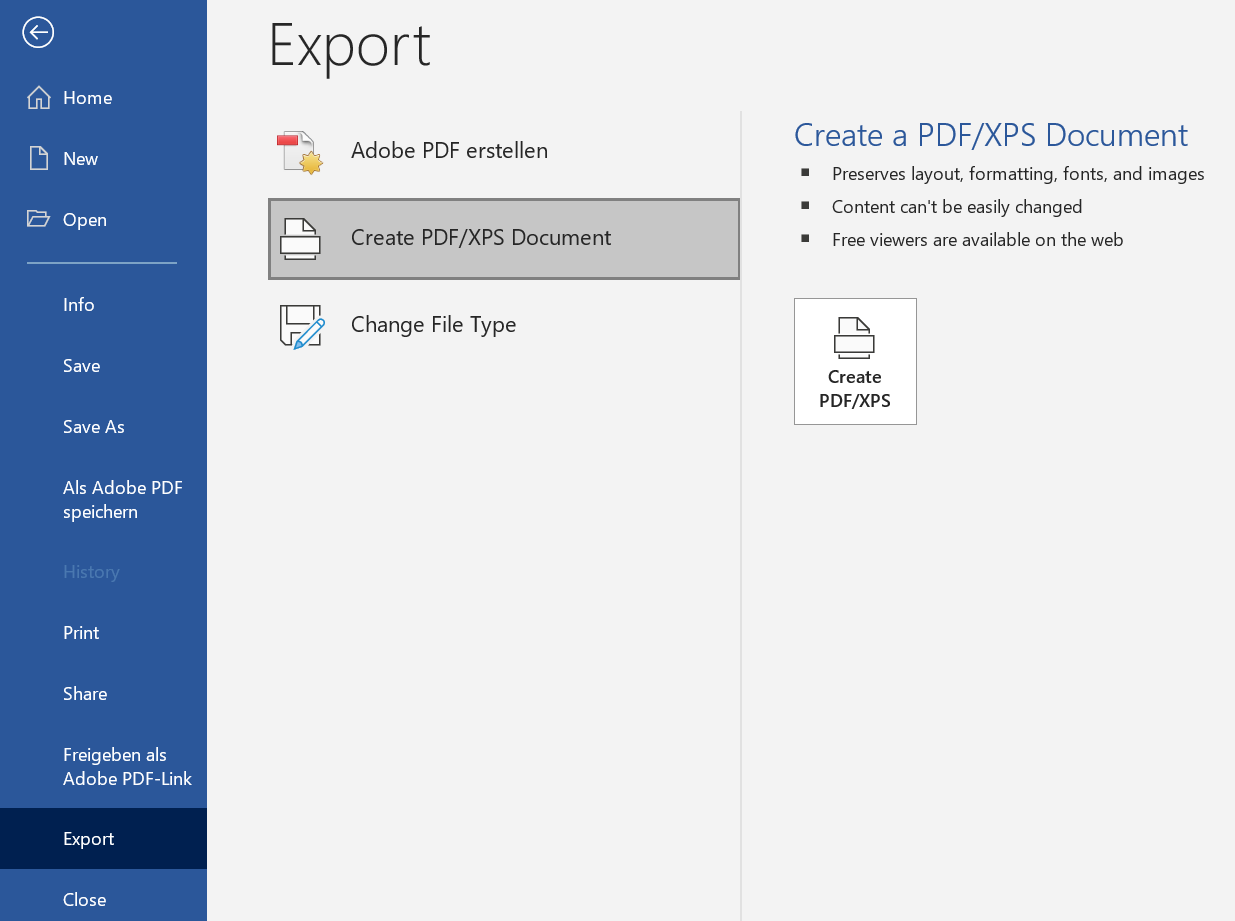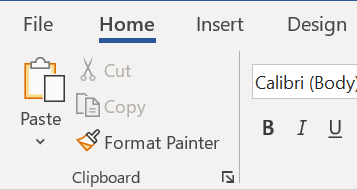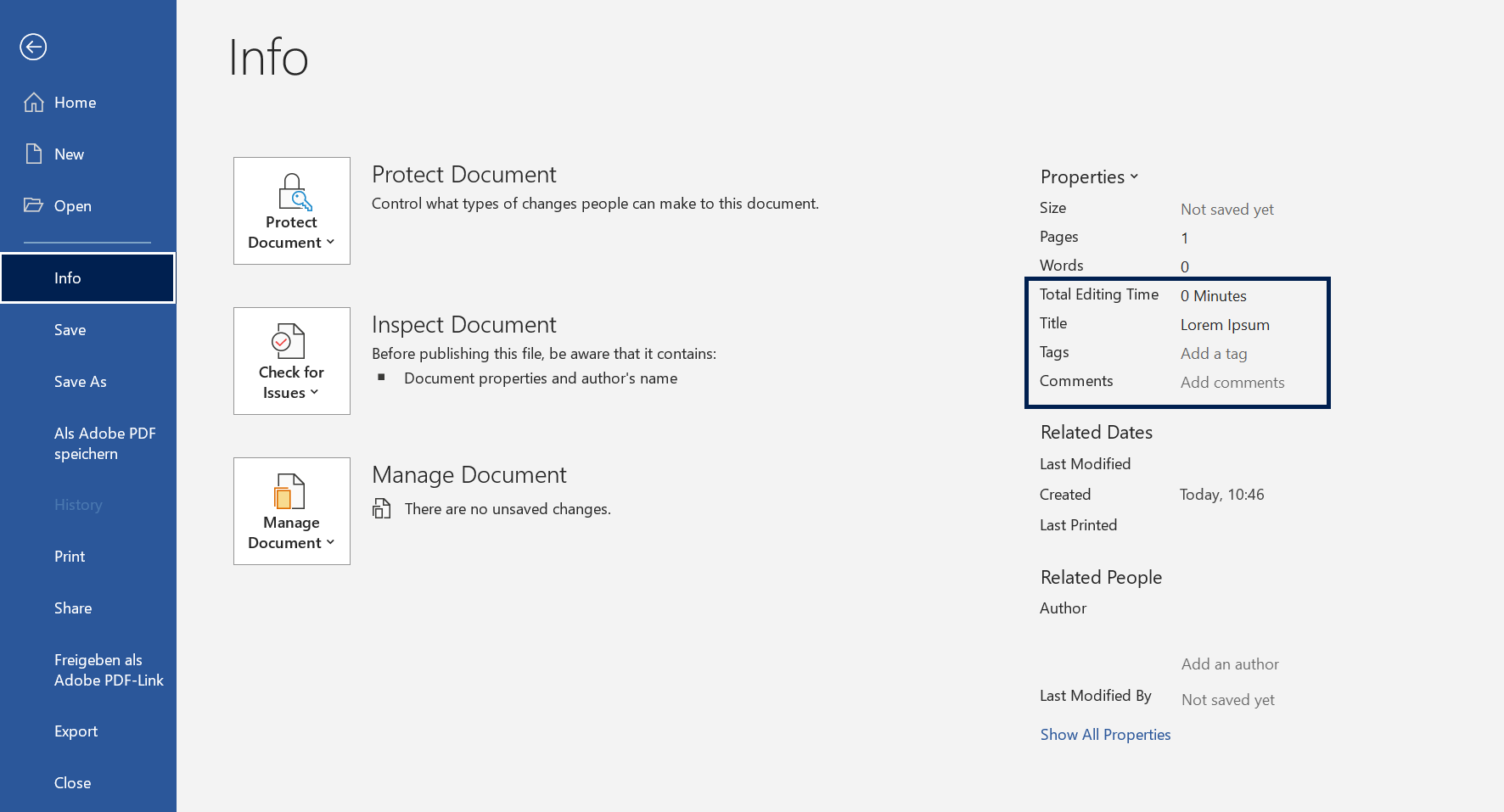It is an ethical and legal obligation to provide accessible content to blind and visually impaired people. The following information is intended for our authors, editors, contributors to book projects, and anyone interested in learning more about accessible publishing.
There are three dimensions to accessibility: the content, special layout and structural elements (such as tables, images, diagrams, formula environments), and the technical format such as Portable Document Format (PDF) or Electronic Publication Format (EPUB).
It is especially important to use the standard features of your word processing program for all semantic or highlighted content, layout, and structural elements. In Word, for example, use the appropriate styles "Heading 1", "Heading 2", etc. for headings instead of manually setting the font to "large and bold". This is the only way that blind people, for example, can use a screen reader to quickly jump from chapter to chapter and use these structural elements for orientation.
Alternative text is required for all images, diagrams, and formulas for the blind. These must be true descriptions of the content to be seen, not just repetitions of the image caption. Colorblindness must also be considered. Please do not use charts that can only be interpreted by the selected colors, and do not use additional patterns or display variations such as dotted lines, dashed lines, or the like. Avoid complex or nested tables, as these are often difficult for screen readers to read clearly.
In terms of technical format, PDF is the least accessible because a lot of information can be lost when converting from Word. For example, the correct reading order for screen readers or structural markers such as section breaks. In addition, making PDFs accessible in accordance with standards such as ISO 14289-1 and WCAG (Web Content Accessibility Guidelines) requires a great deal of work.
This cannot be done by FAU University Press, so please refer to service providers (see below). The Hypertext Markup Language (HTML) or Electronic Publication (EPUB) formats are more suitable. We would like to invite you to participate in the beta test of the Open Source Academic Publishing Suite (OS-APS) and SciFlow Publish: https://www.university-press.fau.de/en/publizieren/betatest-der-open-source-academic-publishing-suite-os-aps-und-sciflow-publish/. This will allow you to create dynamic formats.
Below you will find tips on how to make the final formats accessible, or at least as accessible as possible, or how to support this with simple measures or service providers.
External service providers
If the steps described below for preparing and creating accessible documents are too time-consuming for you, but you still want to ensure the digital accessibility of your planned eBook, you can hire a service provider of your choice. They will take on the task of creating an accessible PDF.
Please use the FAU University Press Book Submission Form to let us know at the beginning of the book project if you prefer a specific service provider. Otherwise, we usually work with one of the following two vendors.
Especially if you have or can apply for third-party funding for the book, we strongly recommend this option, as more and more third-party funders support digital accessibility and open access to research results.
Below are examples of two trusted partners. Of course, we can respond to your wishes and requests and commission others.
From Word to accessible PDFs
The following guide with images is largely based on Müller, Emma; Voegler, Jens (2020): Barrierefreie Dokumente – Anleitung zur Erstellung barrierefreier PDF-Dokumente mit Word. Technische Universität Dresden. Available online at https://nbn-resolving.org/urn:nbn:de:bsz:14-qucosa2-739676. Content is licensed under the CC BY-NC-SA 4.0 License. Truncations and changes have been made. Unless otherwise noted, changes are also licensed under CC BY-NC-SA 4.0. If you prefer a video, we recommend "From Word to PDF" by the Publications Office of the European Union (https://www.youtube.com/watch?v=9n-insewE10).
This section provides specific instructions for converting your Word document into an accessible PDF. The instructions include the main steps you should follow when creating an accessible document: Setting document properties, performing text editing and image description, creating the PDF document, and finally checking it.
Following the guidelines does not automatically guarantee an accessible PDF document. Further specific checks are required, e.g. with the PDF Accessibility Checker (see also Checking tools below).
This guide refers to Word on Windows. There are some differences for Word on MacOS that can be found in the original document referenced above.
Activate accessibility check
Since Office 2010, a built-in accessibility checker has been available in all Office applications. As of Word 2019, there is an Accessibility Check menu item on the Check ribbon. If you keep the Accessibility Check window open after you turn on the accessibility check, you can see any accessibility issues in real time as you write.
You can also run the accessibility check later as a separate step before exporting the PDF. For more information, see "Accessibility check with Office" below.
Default Templates
Each document has default styles for each text element. In the Styles group of the Ribbon you will find the Quick Styles list, which contains a selection of all available styles. If you open the Styles pane from the toolbar and select Select styles to display: all, a list of all styles available in the document will be displayed. To apply a style to a section of text or a heading, select the text and then select the desired style.
Document Properties
Word Processor
After these preparations, you can start the real work: creating the content. All visual properties of the text (font size, color, spacing, paragraphs, etc.) should be organized in style sheets. Avoid positioning text with spaces and empty lines. You can check your document for existing spaces and lines by displaying the formatting marks (Figure 4).

Avoid manual or automatic hyphenation in your document. These are usually not implemented correctly when converted to PDF. Select "none" for the hyphenation options. Also, you should always use Word's multi-column feature, and not, for example, frameless tables.
When a separate (free-form) text box is used to highlight information, it is usually visually related to the adjacent text or image. In order for this relationship to be represented structurally, the appropriate "anchor" must be placed in the correct position. To do this, drag the anchor icon that appears when you select the text box onto the paragraph to which the text box belongs. The content of the text box will then be placed after the text of that paragraph in the reading order.
Please note that the frame of the text box will be recognized as an image element during conversion to PDF, so you should provide the text box with an alternative text. Please also make sure that the anchor is set to the correct position for all images or that the line break option "With text in line" is selected so that the reading order of the elements corresponds to the optical reading order when converting to PDF.
Images
Check accessibility with MS Office
Before exporting a Word document to PDF and then having to make time-consuming improvements to the PDF document, it is worthwhile to run an internal Office check for accessibility issues before exporting. However, fixing problems in Office does not mean that there will be no problems in the exported PDF document.
Since Office 2010, a built-in accessibility checker is available in all Office applications. Starting with Word 2019, there is a menu item on the Check ribbon tab. In older versions, the check is started from the file information. The Accessibility toolbar opens in the right sidebar. At the top of the toolbar is a list of errors and warnings, grouped by type. Clicking on an error or warning immediately selects the affected item, so you do not have to search for it first. Below the list is an area that provides more detailed information about the selected error. Here you will also find the reasons why the correction is necessary and instructions on how to correct the error.
Create a PDF document
Now all you need to do is export your document as a PDF (Figure 5). We do not recommend using a PDF printer because it does not export the logical structure.

In the Create PDF / XPS dialog box, you can specify the file name, file type, and location for the final publication. As an alternative to the steps described above, you can also open this dialog by pressing the F12 key, but then you must select PDF as the file type. PDF export settings can be made using the Options button in the dialog. Set the following options. Confirm with the Ok button and save the document with the Publish button.
- Option "Create bookmarks using: Headings": All headings will be converted to bookmarks if you have worked with style sheets and used headings accordingly.
- Option "Document Properties": Adds information to the PDF, such as the title of the document.
- Option "Document structure tags for accessibility": All structure information is transferred to the PDF.
- Disable "Bitmap texts when fonts [...]". This would cause text content to be saved as image information, making it unreadable to non-visual users.
Create accessible PDFs from LaTeX
Unfortunately, LaTeX is currently rather unsuitable for creating accessible documents and should be avoided. Packages introduced in the past such as accessibility (https://ctan.org/pkg/accessibility) or axessibility (https://ctan.org/pkg/axessibilityare no longer fully developed and will no longer be maintained.
There is a new experimental package called tagpdf (https://ctan.org/pkg/tagpdf) that provides tools for experimenting with tagging and accessibility using pdfLaTeX and LuaTeX. It works partially for simple documents, limited to standard classes, standard commands, and already supported packages. The more complicated the document and the more external packages it contains, the more likely it is to have problems. Accordingly, tagpdf is not yet integrated into the FAU University Press templates, and we have not yet been able to get it to work correctly.
There are a few websites that give general recommendations and tips on accessibility in LaTeX outside of special accessibility packages. However, most of these are outdated. Lewis Forbes' blog "LaTeX and Accessibility" is a relatively up-to-date resource (https://blogs.ed.ac.uk/isintern/2023/08/15/lewis-forbes-latex-and-accessibility/). Hier wird teilweise auch beschrieben, was nicht mehr funktioniert, z.B. Alternativtexte über das oben genannte Accessibility-Paket. Laut Lewis Forbes kann man Alternativtexte derzeit noch über diese beiden Wege hinterlegen:
- „Using a parameter on caption \caption[alt text]{caption text} […]. This should be used when \includegraphics{} is used within a \figure{} environment.
- Using \pdftooltip{} from the pdfcomment interface successfully added tooltips with user-specified text to the document, which Ally recognized as alt text. This should be used when \includegraphics{} is being used with no \caption{}. For example, I used it in a \subfloat{} environment.“
In an example based upon the DOI: 10.1090/noti2606 page 70, the latter procedure could be as follows: a square is drawn and provided with alternative text:
\usepackage{pdfcomment}
\pdftooltip{
\begin{tikzpicture}
\draw (0,0) — (1,0) — (1,1) — (0, 1) — (0, 0);
\end{tikzpicture}
}{Here is a square rectangle with black lines, without colored filling.}
The title and language of a PDF document can be specified by the following lines in the preamble of the document:
\usepackage{hyperref}
\hypersetup{pdftitle={Document Name}, pdflang={en-GB}}
In general, however, the recommendation mentioned at the beginning applies: If you want a PDF that is as accessible as possible, please use Word and the Word recommendations mentioned here to create your manuscript, or, in the case of LaTeX documents, plan to hire a service provider to do the final preparation.
Support provided by SciFlow Publish and OS-APS or OS-APS_STEMO
The project "Ausbau der Open Source Academic Publishing Suite für komplexe STEM-Publikationen und optimierte Online-Darstellungen" supports digital accessibility in several areas.
In the future, OS-APS (https://os-aps.de/) and SciFlow Publish will integrate accessibility checking functionality, and the planned JATS/BITS reader will support popular screen readers, making content accessible to blind and visually impaired people on almost any device without conversion.
With OS-APS you can generate HTML files from your manuscripts. You can then check and optimize the HTML e-book using the checking tools (see below) or the Web Accessibility Checker. XML exports are also possible with OS-APS. With the help of tools such as Calibre (https://calibre-ebook.com/), it would also be possible to generate an EPUB e-book from the HTML or XML file.
FAU University Press has also licensed a trial version of the commercial software SciFlow Publish, which can be used to generate EPUB files directly. Join the beta test of SciFlow Publish: https://www.university-press.fau.de/en/publizieren/betatest-der-open-source-academic-publishing-suite-os-aps-und-sciflow-publish/.
Testing Tools
To avoid misunderstandings, files that are classified as accessible by the test tools are usually only compliant with the underlying technical standards (e.g. ISO 14289 (PDF/UA) or W3C Accessibility Standards such as WCAG). In practice, however, they can still be unusable for blind people due to poor alternative texts, for example. Accessibility must therefore be based on actual usability for people with disabilities. See, for example, the section "Characteristics of Good Image Descriptions" under "From Word to accessible PDFs".
For accessible PDF files
For help fixing bugs found by the following testing tools, see the page "Barrierefreies Webdesign". (https://www.barrierefreies-webdesign.de/knowhow/pdf-ua/). Simply paste the error message into the search field and follow the step-by-step instructions using Adobe Acrobat Pro.
It is also advisable to intellectually check the reading order of the PDF - either by viewing it in Adobe Acrobat Pro ("Order" in the left column), or by reading the document with the help of Adobe Acrobat's speech output or a freely available screen reader such as NVDA (https://nvda.bhvd.de/) vorlesen lässt.
For accessible EPUBs
For accessible HTML eBooks
Visit the W3C Web Accessibility Initiative (WAI) Web site for a comprehensive list of Web accessibility evaluation tools: https://www.w3.org/WAI/test-evaluate/tools/list/For a quick guide to choosing an appropriate tool, visit https://www.w3.org/WAI/test-evaluate/tools/selecting/. For a free browser-based tool, see the following WAVE Web Accessibility Evaluation Tool:https://www.w3.org/WAI/test-evaluate/tools/selecting/) bietet eine kurze Anleitung zur Auswahl eines geeigneten Tools.. Für ein browserbasiertes, kostenloses Tool siehe nachfolgendes WAVE Web Accessibility Evaluation Tool:



